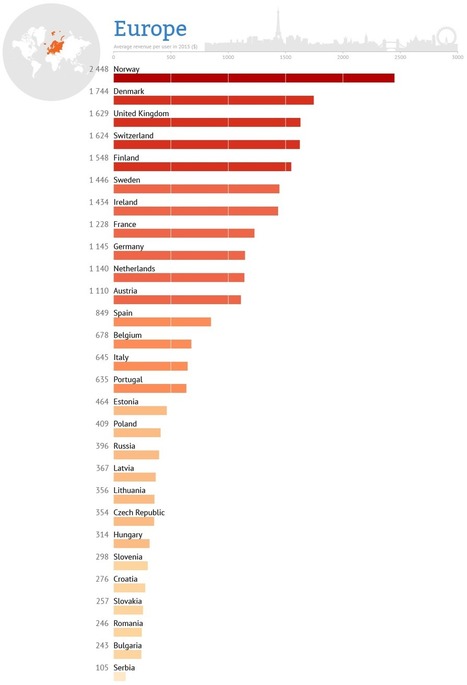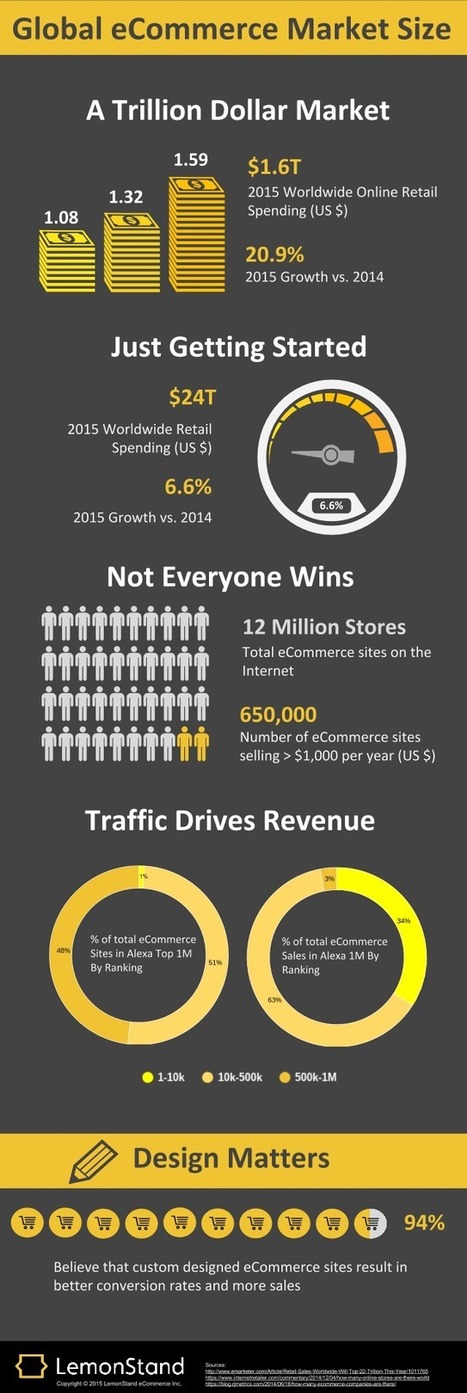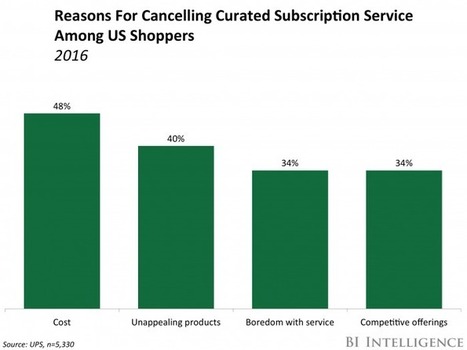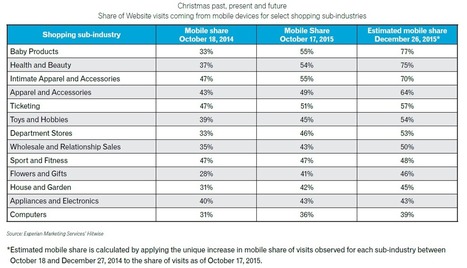 Your new post is loading...
 Your new post is loading...
Retail ecommerce sales—which include products and services (barring travel, restaurant and event ticket sales) ordered via the internet over any device—will reach $1.915 trillion in 2016, accounting for 8.7% of total retail spending worldwide. While the pace of growth for overall retail sales is subdued, the digital portion of sales continues to expand rapidly, with a 23.7% growth rate forecast for 2016. eMarketer expects retail ecommerce sales will increase to $4.058 trillion in 2020, making up 14.6% of total retail spending that year.Asia-Pacific will remain the world’s largest retail ecommerce market throughout the forecast period, with sales expected to top $1 trillion in 2016 and more than double to $2.725 trillion by 2020. The region will also see the fastest rise in retail ecommerce sales, climbing 31.5% this year. Expanding middle classes, greater mobile and internet penetration, growing competition of ecommerce players and improving logistics and infrastructure will all fuel ecommerce growth in the region. The bulk of retail ecommerce will come from China, where sales are expected to reach $899.09 billion this year, representing almost half (47.0%) of all such sales worldwide. While there is plenty of opportunity for growth, parts of Asia-Pacific are still faced with challenges. In Southeast Asia in particular, ecommerce still represents only a fraction of total retail sales. An underdeveloped digital payments infrastructure and a weak logistics framework have made these markets unprepared to handle high volumes of ecommerce orders and have kept ecommerce at a nascent stage....
In total, 2016 Prime Day was the biggest U.S. sales day ever, surpassing Cyber Monday 2015 by 19%, according to Slice Intelligence, which measures all digital commerce activity and customer loyalty. Slice also found that, on Prime Day, Amazon held 74% of the market share of all U.S. consumer ecommerce.
Sales totals aside, here are some significant takeaways from Prime Day pertaining to Amazon’s customer relationships: - By offering exclusive deals to members, Amazon continued to showcase the value and advantages of Amazon Prime. Membership continues to grow, from an estimated 75 million at the end of 2015 to 85 million now — with projections that it will reach 110 million by the end of 2016.
- The deepest discounts seemed to be for Amazon devices such as the Tap, Echo and Kindle Fire. Despite the low cost, the premium devices align consumers even more closely with Amazon and make it easier for them to shop and order – thereby facilitating future purchases with the online retailer.
- Prime Day also stimulated customer engagement through the Amazon app. Survey Monkey, which tracks mobile app usage, reported 12 million mobile users on Prime Day, a 50% increase from the 8 million users on an average day. Usage for the week went up 35% in all. Research further showed that 50% of Walmart app users also use the Amazon app — however, very few Amazon app users also use Walmart’s app, demonstrating Amazon’s dominance in the category.
- The opportunity to reach new customers outweighed the negative experiences of others. Some glitches were reported, such as problems with checkouts early in the day and complaints on social media that sale prices applied to a limited number of products. But the record number of new subscribers far surpassed the number of shoppers who were dissatisfied with the event. Ultimately, Amazon may view that as a worthwhile trade-off, banking on the recurring revenue from new customers who will spend more time on Prime and increase their lifetime value....
Consumers are increasingly turning towards messaging, such as SMS and chat apps like Facebook Messenger and WhatsApp to engage with retailers, a global study has found.
Research from global trade body Mobile Ecosystem Forum (MEF) supported by Mblox says that 76% of consumers have received communications from businesses such as retailers, banks and healthcare providers via SMS and that 65% have engaged with companies via chat apps.
The study, part of MEF’s Future of Messaging Programme, indexes the messaging habits of nearly 6000 respondents across nine countries worldwide. The financial services sector is the most active in enterprise messaging, with 33% of respondents having received an SMS for activities such as account activation and balance checking. 22% have done so via a chat app.
Retailers and eCommerce (websites and email service providers) are also using messaging to engage their consumers with 24% using SMS and 17% using chat apps. 23% of consumers have received a notification for delivery of goods via SMS and 16% via a chat app. The rise in demand for convenience with services like click-and-collect and last-mile notification is helping to drive this sector....
Via Douglas G Hall
Retail profits are plummeting. Stores are closing. Malls are emptying. The depressing stories just keep coming. Reading the Macy’s, Nordstrom, and Target earnings announcements is about as uplifting as a tour of an intensive care unit. The Internet is apparently taking down yet another industry. Brick and mortar stores seem to be going the way of the yellow pages. Sure enough, the Census Bureau just released data showing that online retail sales surged 15.2 percent between the first quarter of 2015 and the first quarter of 2016. But before you dump all of your retail stocks, there are more facts you should consider. Looking only at that 15.2 percent “surge” would be misleading. It was an increase was on a small base of 6.9 percent. Even when a tiny number grows by a large percentage terms, it is often still tiny. More than 20 years after the internet was opened to commerce, the Census Bureau tells us that brick and mortar sales accounted for 92.3 percent of retail sales in the first quarter of 2016. Their data show that only 0.8 percent of retail sales shifted from offline to online between the beginning of 2015 and 2016. So, despite all the talk about drone deliveries to your doorstep, all the retail execs expressing angst over consumers going online, and even a Presidential candidate exclaiming that Amazon has a “huge antitrust problem,” the Census data suggest that physical retail is thriving. Of course, the shuttered stores, depressed execs, and tanking stocks suggest otherwise. What’s the real story?...
AT Kearney released a report – The 2015 Global Retail E-Commerce Index. Their research analyzes retail e-commerce around the globe and ranks countries according to its proprietary Global Retail E-Commerce Index.™
The biggest news for this year’s index is that e-commerce continues to grow strongly in big markets and small with only a few exceptions. The index ranks countries by several criteria: online market size (40%), consumer behavior (20%), growth potential (20%) and infrastructure (20%) weighted to arrive at an overall Online Attractiveness Score....
In terms of online spending there are many differences in Europe. A new infographic shows the average online spending in Europe. The infographic was made by Expert Market, using data from Statistica’s Digital Market Outlook. The British company ranked the countries that spend the most money online per average customer. To make it easier for comparison they put all the amounts in US dollars.
The global ranking shows Europe is doing pretty well, considering Norway is the number two with $2,448 spent online per average customer in 2015. Only the average revenue per user in Hong Kong was higher, with $2,868. In total, seven European countries ended in the global top 10, which consists of: Hong Kong, Norway, Israel, the United States, Denmark, the United Kingdom, Switzerland, Finland, Sweden and Ireland....
If you are in the eCommerce market industry, you'll be smiling by the time you finish reading this article.
Robert Moore from RJMetrics took this a step further, identifying that 11 percent (110,000) of the top 1M websites on the internet by Alexa traffic ranking are eCommerce sites and calculating the distribution of these websites in total numbers as well as by share of retail sales, and came up with some very interesting results shown in the table below.
From this research, we know that the top 1% (Amazon, eBay, Walmart among them) of the top visited eCommerce sites on the Internet are capturing 34% of total sales. This is unsurprising for such big companies, with huge brands, and huge marketing dollars backing them. We call this the “fat head” (vs. long tail) of eCommerce stores and it is a very elite group. In the mid tier, eCommerce stores that break into the top 500,000 in Alexa rankings make up 51% of the total businesses and 63% of total revenue, still a very healthy showing....
|
As of the first quarter 2016, the total amount of retail spending online (ecommerce) was $92.8 billion, which was only 7.8% of all retail sales. Ecommerce is in its infancy, which means that there are huge opportunities ahead, not just for the types of Amazon, but for small merchants and startups as well.
Worldwide retail sales, including in-store and internet purchases, surpassed $22 trillion in 2015, up 5.6% from 2014, according to a study by eMarketer. They say that retail ecommerce sales, those purchased over the internet, will make up 7.4% of the total retail market worldwide, or $1.671 trillion. By 2019, that share will jump to $3.578 trillion, yet retail ecommerce will still only account for 12.8% of all retail purchases.
Even though the internet and technology is the source of major disruption for retailers, brick and mortar is alive and well for the foreseeable future.
The study says that retail ecommerce sales are accelerating faster than previously anticipated and will jump 25.1% year on year in 2015. "Online sales growth will outpace brick-and-mortar sales growth by a more than 3-to-1 margin over our forecast period," the report predicts....
The rate of eCommerce growth as steadily outpaced total retail growth by a multiple of three to four times, Amazon.com’s growth has outpaced eCommerce by one to two times, giving it a dominant lead in many of the world’s most mature eCommerce markets. According to Forrester, Amazon drove 60% of total US online sales growth in 2015, capturing $23 billion more in U.S. eCommerce sales in 2015 than the previous year (up from $77 billion in 2014 to $100 billion). Alex McCord of Compass Marketing, an agency which works with some of the world’s largest CPG brands: “We’re now seeing the advent of what I’ll call e-commerce native companies: companies that come onto Amazon and other e-retailers and who are able to gain traction through getting a ton of recent reviews. They know how to work the Amazon algorithm and then launch products that, from the perspective of a brand in the brick-and-mortar world, have as low as zero market share. But in the world of unbranded search on Amazon and other retailers, they’re enormous players.” So who is winning on Amazon? Profitero analyzed our Amazon FastMovers reports between January-May 2016 to rank the best-selling products at Amazon in several key categories. We then identified the number of products that featured in the top 100 best sellers by brand to determine best-selling brands by category....
Subscription services have become popular among online shoppers, but those same shoppers are also abandoning these services.
Through these subscriptions, customers make recurring payments and receive order shipments at regular intervals, and they have become popular because they let consumers refill products they need to replenish often, such as health and beauty products.
These services typically personalize orders based on a shopper's interests and style, which the companies often learn through connected social media accounts and quizzes. This experience mirrors the personalized service customers would get inside brick-and-mortar stores from sales associates.
So interest in these services has remained high, as 10% of U.S. shoppers have enrolled in one, and another 33% would consider doing so, according to the latest UPS Pulse of the Online Shopper report.
But satisfaction in these services is dropping, as 61% of those who have signed up have since canceled. And there are four main reasons why....
There are a bunch of aspects to running an e-commerce business but when you boil it down, everything comes back to how your website, brand, and products are perceived by consumers. You can have your own assumptions of what will work but how do you really know what’s going to drive a shopper to convert into a sale?
Our friends over at Bargain Fox have helped us all out with an in depth look at e-commerce consumer psychology. Are you ready for 65 stats that will help you transform your e-commerce marketing, website design, customer engagement strategy, and overall sales numbers? Check out this epic e-commerce infographic!...
It was yet another great quarter in the world of US retail e-commerce. Revenue was up by 11.8 percent year over year, and transactions increased nearly the same amount (11.6 percent) over Q3 2014.
As the leaves begin to change color and the sun begins to set on 2015, let’s take a look at some of the trends leading the way into Q4 and this year’s holiday shopping season.
These finding below are based on the Custora E-Commerce Pulse, a free online dashboard tracking online transactions from more than 500 million shoppers, $100 billion in e-commerce revenue, and 200+ online retailers....
This holiday is poised to be the first mobile-dominant season for retailers and marketers need to be ready.
A growing number of Americans are turning to their smartphones and tablets as their primary device for accessing the Internet. In fact, one-third of all U.S. adults (33.7 percent) say they access the Internet more often through a mobile device than through a computer, up from 24 percent in 2013. Furthermore, Millennials are the first generation to be mobile dominant, with 53 percent of consumers aged 18 to 34 reporting that they use their phone more often than a computer to go online.
Considering that trend, it’s no surprise that when pulling data for our Holiday Hot Sheet series, we found that 35 percent of all Website visits came from smartphones or digital tablets during the week ending October 17, 2015. Shopping and Classified Websites, however, received an even greater share of visits from mobile devices that week, 44 percent to be exact. And some shopping sub-industries got a majority of traffic from mobile. Those included: Intimate Apparel and Accessories, which currently gets 55 percent of visits from mobile, Baby Products (55 percent), Health and Beauty (54 percent) and Ticketing (51 percent)....
Recent online shopping statistics have found that over two-thirds of Americans have made an online purchase. According to ComScore, this equates to approximately 78% of the entire population that’s over the age of 15.Needless to say, ecommerce is big business, and isn’t going anywhere, anytime soon. We’ve highlighted this nuance in a recent guide we penned: Bricks vs. Clicks: How the Ecommerce Monster is Slowly Ingesting Brick & Mortar Retail.
Look to it for more insight on how brick and mortar is slowly but surely being overtaken by ecommerce (even though it will never cease to be; ecommerce is catching up fast)....
With the advancing age, marketing and shopping trends are advancing too. 2015 is expected to set all new trends in ecommerce. Marketers need to be aware of these ecommerce trends in 2015 so as to remain visible amidst strict competitioyn.
With increasing technology and gadgets, ecommerce is reaching almost everyone. People are feeling more comfortable while buying products online and getting them on their door steps. So, let’s look at the key ecommerce trends in 2015....
|



 Your new post is loading...
Your new post is loading...




























With the season of Black Friday, cyber Monday and xmas shopping, eCommerce trends are worth looking at. And the conclusion is clear: DO or DIE.